
St. Peter's Episcopal Church, also known as St. Peter's Church, is located in downtown Albany, New York, United States. It was designed in the mid-19th century by Richard Upjohn and his son Richard M. Upjohn in the French Gothic Revival architectural style. It was listed on the National Register of Historic Places in 1972, and designated a National Historic Landmark eight years later. It is also a contributing property to the Downtown Albany Historic District.

The Emmanuel Episcopal Church in Rapid City, South Dakota is an historic Gothic Revival sandstone Episcopal church located at 717 Quincy Street. In 1975, Emmanuel Church was added to the National Register of Historic Places.

Christ Episcopal Church, also known as Christ Church on Capitol Square, is an Episcopal church at 120 East Edenton Street in Raleigh, North Carolina. Built in 1848–53 to a design by Richard Upjohn, it is one of the first Gothic Revival churches in the American South. The church was built for a parish established in 1821; its minister is the Rev. James P. Adams. It was declared a National Historic Landmark in 1987.

Grace Church is an historic Episcopal church at 300 Westminster Street at Mathewson Street in downtown Providence, Rhode Island. It was built in 1845-46 and was designed by Richard Upjohn in the Gothic Revival style.

The parish of Trinity Church, Elmira, New York was founded in 1833. Trinity Church is a parish of the Chemung District of the Episcopal Diocese of Central New York, centered in Syracuse, New York. The present structure of Trinity Church is located at 304 North Main Street, Elmira, New York. Designed by architect Henry Dudley, the church was built from 1855 through 1858. It is significant for its Gothic Revival architecture. The church was listed on the National Register of Historic Places in 2007.
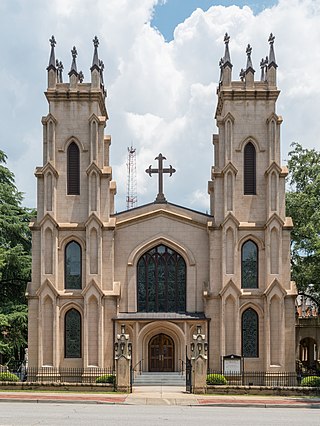
Trinity Episcopal Church, now known as Trinity Episcopal Cathedral, is the first Episcopal and the oldest surviving sanctuary in Columbia, South Carolina. It is a Gothic Revival church that is modeled after York Minster in York, England. It was named to the National Register of Historic Places on February 24, 1971.
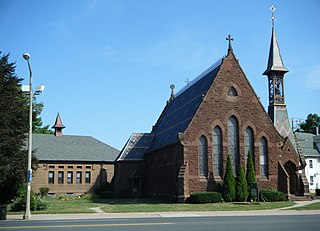
St. John's Episcopal Church is a historic church building at 1160 Main Street in East Hartford, Connecticut. It was designed by Edward T. Potter and was built in 1867, and is a prominent local example of High Gothic Revival executed in stone. Its congregation, begun as an Episcopal mission in 1854, has recently been merged into the St. John's Episcopal Church in Vernon. The building was listed on the National Register of Historic Places in 1983.
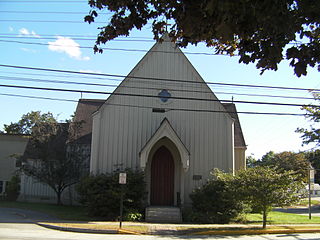
St. Paul's Episcopal Church is a historic church at 27 Pleasant Street in Brunswick, Maine. Built in 1845, it is a distinctive early example of a modest Carpenter Gothic design by Richard Upjohn, then already well known for his larger-scale Gothic churches. The building was listed on the National Register of Historic Places in 1978. The rector is Rev. Carolyn H. Eklund.

Holy Trinity Episcopal Church also known as Holy Trinity Memorial Church is an historic Episcopal church building located at 38 Grand Avenue in the village of Swanton, Franklin County, Vermont. Built in 1876 and expanded in 1909-10, the church facilities include a fine example of the Carpenter Gothic in the older section, and the Late Victorian Gothic Revival in the newer section. The church was listed on the National Register of Historic Places as the Parish of the Holy Trinity in 2001. The church is an active parish in the Episcopal Diocese of Vermont; its current rector is the Rev. Reid D. Farrell.

St. Thomas' Episcopal Church is located on Leedsville Road in Amenia Union, New York, United States. It is a mid-19th century brick church designed by Richard Upjohn in the Gothic Revival architectural style, built for a congregation organized shortly before.

St. James' Episcopal Church is a congregation of the Episcopal Church in La Grange, Texas, under the Episcopal Diocese of Texas. Its campus at Monroe and Colorado Streets includes its historic parish church as well as a sacristy, preschool, and parish hall.
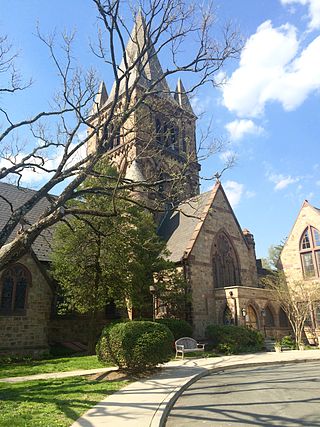
Trinity Church is a historic Episcopal congregation located at 33 Mercer Street in Princeton, New Jersey. It is the largest Episcopal church in New Jersey.
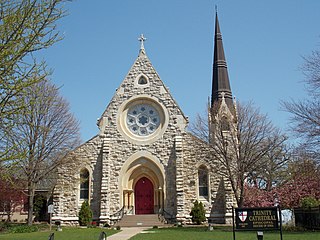
Trinity Episcopal Cathedral, formerly known as Grace Cathedral, is the historic cathedral in the Diocese of Iowa. The cathedral is located on the bluff overlooking Downtown Davenport, Iowa, United States. Completed in 1873, Trinity is one of the oldest cathedrals in the Episcopal Church in the United States. It was individually listed on the National Register of Historic Places in 1974. In 1983 the cathedral was included as a contributing property in the College Square Historic District, which is also listed on the National Register.

St. Paul's Episcopal Cathedral, is located in downtown Des Moines, Iowa, United States. It is the cathedral church of the Episcopal Diocese of Iowa. The building was listed on the National Register of Historic Places as St. Paul's Episcopal Church.

St. John's Episcopal Church is a parish church in the Episcopal Diocese of Iowa. It is located in Keokuk, Iowa, United States. It was listed, together with the parish hall, on the National Register of Historic Places in 1989.

Trinity Episcopal Church is a parish church in the Diocese of Iowa. The church is located in Muscatine, Iowa, United States. It was individually listed on the National Register of Historic Places in 1974. In 2006 it was included as a contributing property in the Downtown Commercial Historic District.
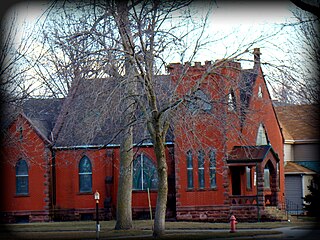
Trinity Memorial Episcopal Church is a former parish church in the Episcopal Diocese of Iowa. The historic building is located in Mapleton, Iowa, United States. It was listed on the National Register of Historic Places in 1990. The former church building and hall now house the Museum of American History.
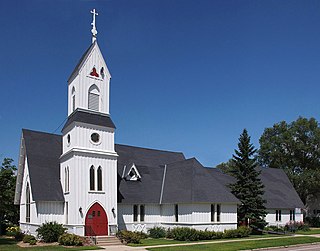
Trinity Episcopal Church is an Episcopal church in Litchfield, Minnesota, United States, built in 1871 in Carpenter Gothic style. It has been attributed to the noted New York architect Richard Upjohn. It was listed on the National Register of Historic Places in 1975 for having local significance in the theme of architecture. It was nominated as a superlative example of Carpenter Gothic design from the mid-19th century.

St. John Chrysostom Church, also known as the Episcopal Church of St. John Chrysostom and the Little Red Church on the Hill, is a wooden Episcopal church built in 1852 in Delafield, Waukesha County, Wisconsin. In 1972 it was listed on the National Register of Historic Places.

The St. James Episcopal Church, located in downtown Baton Rouge, Louisiana, is a congregation of the Episcopal Diocese of Louisiana. Although Episcopalians began gathering in 1819, St. James Church formally organized as an Episcopal congregation in 1844 due to the influence and support of Margaret MacKall Taylor, wife of president Zachary Taylor. Within the spectrum of worship styles in the Anglican tradition, St. James Church was a Low Church parish during the 19th century, but has been considered a Broad Church parish since the early to mid 20th Century. In addition to worship, St. James Church is actively involved in service to the community, pastoral care, and Christian education for all ages. The church is also home to a two-time National Blue Ribbon day school.

























